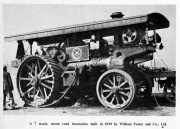William Foster and Co

William Foster and Co of Wellington Foundry, Lincoln (Fosters of Lincoln) was an agricultural machinery company and producer of Traction Engines
See separate sections on -
The company was known for producing threshing machines, regarded as among the best available. They also made traction engines, steam tractors such as the Foster Wellington and Showman's road locomotives.
1856 William Foster, a Miller, started William Foster and made grinding mill and agricultural equipment at Wellington Foundry in Lincoln.
1858 Built the first portable steam engine.
1861 Employing eighty men (in malting, milling and engineering company) [1]
1861 Exhibited at the Royal Agricultural Society of England meeting in Leeds - exhibited portable steam engines and threshing machines[2]
1863 Advertised as a maker of portable engines.
1869 Opened branch works in Budapest and Galtaz (Romania).
1871 Agricultural and General Engine and Machine Makers employing 68 men and 41 boys [3]
1877 Took limited liability and became William Foster and Co.
1889 Built self-propelled traction engine.
1891 Released a catalogue of their steam engines and threshing machines. [4]
1899 Moved to new works called Wellington Foundry.
1900 The works. Article with plan and illustration in The Engineer. [5]
1906 Exhibited tractor at Cordingley's motor show[6]
1910 A joint effort between Fosters and Richard Hornsby and Sons was the Foster-Hornsby Chain Track haulage engine.
WW1 During the First World War they built the first tanks for the British Army. Fosters as builders of agricultural machinery were involved in the production and design of the prototype tanks, which were in effect agricultural tractors with armoured bodies. After the First World War, The Royal Commission on Awards to Inventors decided that the inventors of the Tank were Sir William Tritton, managing director of Fosters together with Major W. G. Wilson.
1919 Built road steam rollers until 1933. Sixty of these were produced.
1920 Article on the birth of the tank in The Engineer (18th June). [7]
1920 At Darlington Royal Agricultural Show they exhibited steam wagons with compound engines. [8]
1927 See Aberconway for information on the company and its history.
1927 A "working arrangement" was made to form a new company Gwynnes Pumps to acquire the Hammersmith iron works, which made pumps, of Gwynnes Engineering Co[9] which was in liquidation. The manufacturing work would eventually be transferred to Lincoln[10].
1942 Made last traction steam engine, possibly the last one made by any company in the UK.
1961 Acquired by W. H. Allen, Sons and Co, including its wholly owned subsidiary Gwynnes Pumps Ltd[11].
See Also
Sources of Information
- [1] Wikipedia
- Traction Engine Album by Malcolm Ranieri. Pub 2005
- Steam Engine Builders of Lincolnshire by Ronald H. Clark. Published 1955 by Goose and Son
- ↑ 1861 Census
- ↑ The Farmer's Magazine, 1861
- ↑ 1871 Census
- ↑ The Engineer 1891/04/10
- ↑ The Engineer of 7th September 1900 p244
- ↑ The Times, 24 March 1906
- ↑ The Engineer of 18th June 1920 p624
- ↑ The Engineer of 16th July 1920
- ↑ The Times, 10 February 1927
- ↑ The Times, 12 February 1927
- ↑ The Times, 19 June 1961












